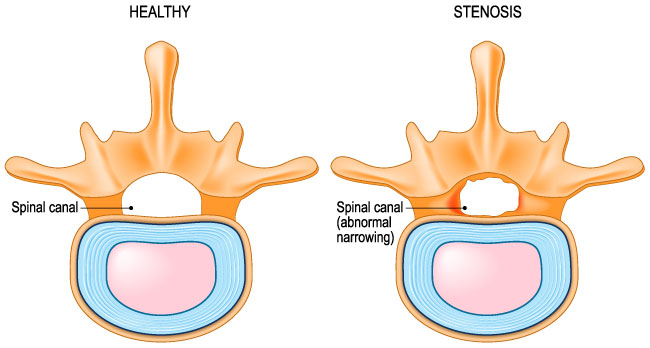What is Spinal Stenosis?
Spinal stenosis is an ailment that occurs with the narrowing of the spinal cord canal or nerve root canal. When this happens it leads to compression of the spinal cord and impingement on the spinal nerve roots. The symptoms you will see, and the problems it will cause, correlate directly to the location(s) of the spine that is effected. The nerves exiting the spine control the function of the muscles and organs throughout the body. When the holes the nerves use to exit the spine are narrowed, the nerve flow is restricted or even cut off entirely.
The spinal column is designed to protect the nerves as they travel down inside the spinal column from your brain to the point of exit in the spine. The proper functioning of the nervous system — which is comprised of the nerves, spinal cord, and the brain — is vital to every movement, function, and control of every aspect of your body. The organs, system, and cells of your body rely on the flow of information throughout the nervous system. If the nervous system is damaged or weakened due to spinal stenosis, our health, immune system, wellness, and overall function will be compromised.
Symptoms of Spinal Stenosis
Spinal stenosis most commonly occurs in the lower back (lumbar spine). If your spinal stenosis is in your lower back, you may feel relief from pain by leaning forward while sitting or standing. Spinal stenosis can also occur in the neck (cervical spine), which is much less common but much more critical. Spinal stenosis in the neck involves direct compression of the spinal cord. In the worst-case scenario, it can lead to partial or even complete body paralysis.
Symptoms related to spinal stenosis is the lower back include:
- Numbness & tingling into the legs and feet
- Pain radiating down into the legs and feet
- Legs cramping
- Loss of sexual function
- Abnormal bladder or bowel function
- Pain walking (particularly up or downhill, stairs, or ramp)
Symptoms related to spinal stenosis in the neck include:
- Numbness & tingling into the arms and hands
- Pain radiating down into the arms and hands
- Serious body weakness
- Paralysis (partial or complete)
Causes of Spinal Stenosis
Osteoarthritis is the most common cause of spinal stenosis. Osteoarthritis can cause bone spurs (osteophytes) to form in the spinal canal, which will narrow the space available for the nerves passing through the spinal canal and cause irritation and pressure on the nerves. In addition to the wear and tear from injuries and stress, osteoarthritis can be caused by spinal subluxations (misalignments) and lack of a proper range of motion in the spine. Osteoarthritis can also lead to disc deterioration, which in turn can hinder or prevent the vertebrae from moving properly, subluxations, and other problems that may put pressure on the nerves.
Osteoarthritis is not the only cause of spinal stenosis. Other major factors and causes include disc herniation, injuries to the spine, surgery to the spine, poor posture, cysts & tumors, as well as thickened ligaments.
At risk individuals include those who sit for a majority of the time, individuals 50 and older, and anyone born with a narrow spinal cord canal (not very common).
Medical Treatment Options for Spinal Stenosis
The current options for medically treating spinal stenosis do not correct the root underlying cause of spinal stenosis, nor do they halt the degenerative process. They are designed primarily to manage your pain symptoms. Pain medications, ranging from prescription to over-the-counter, come with side effects and only provide temporary relief because they do not correct your problem. Epidurals and cortisone injections also only provide temporary pain relief but come with a list of known side effects including high blood sugar, infections, lowered immune response, nerve damage, and localized degeneration and pain
Physical therapy and exercise can also be effectively used to help you function better and increase your muscles strength. While this is helpful, it does not correct spinal stenosis.
Some doctors may recommend surgery. During surgery, they will remove pieces of the vertebrae (laminectomy) and often fuse together multiple parts of the spine. Surgery will reduce your range of motion, and put more pressure on the adjoining vertebrae. Surgery is not a cure for spinal stenosis or osteoarthritis but may bring pain relief.
Chiropractic Care and Treatment of Spinal Stenosis
While tradition treatment may use medications to temporarily mask your pain, it does not correct the problem or stem the progression of spinal degeneration. Chiropractic care is designed to discover the root cause of your problem, correct it, and restore your range of motion and reduce the pain from spinal stenosis.
Chiropractic care is a natural method proven to be safe and effective in treating spinal stenosis. At Tuckahoe Family Chiropractic we will use treatments and techniques such as flexion-distraction, chiropractic adjustments, traction methods, and spinal decompression therapy that work without the risks and side effects of medications, surgery, or epidurals.
The flexion-distraction method can open spinal canal space, realign the vertebrae restoring your range of motion, and relieve the pressure on the nerves. Our patients have reported that along with pain relief, they are experiencing an improved range of motion and a decrease in symptoms.
Contact Tuckahoe Chiropractic at 804.740.3434 to set an appointment today. If you know of others who can benefit from this article, please share and recommend this article.

